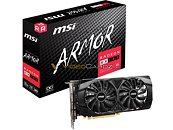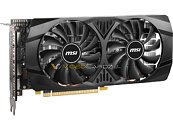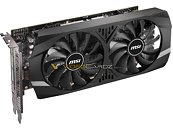Friday, November 15th 2019

MSI Prepares Another Version of AMD Radeon RX 580 Armor Graphics Card
While AMD is giving all signs of being preparing to release their latest entries into the midrange graphics card market in the form of theRX 5500 and RX 5300 series of graphics cards based on Navi, AMD's AIB partners are giving the slow burn on existing inventories of AMD's Polaris graphics chips. MSI, in this case, seems to have bet on a slight redesign of their previously-released RX 580 Armor and Armor MK2.
Changed is the color scheme - MSI went full black on this one. There's also a redesigned PCB, a redesigned I/O bracket (which keeps four display connectors), and a new cooler shroud. The heatsink's surface area also seems to have been increased, which should provide lower operating temperatures (anything beyond that, such as higher overclockability and longer lifespan, are speculations). The redesigned Armor keeps the single 8-pin PCIe power connector. No other details are available at time of writing.
Source:
Videocardz
Changed is the color scheme - MSI went full black on this one. There's also a redesigned PCB, a redesigned I/O bracket (which keeps four display connectors), and a new cooler shroud. The heatsink's surface area also seems to have been increased, which should provide lower operating temperatures (anything beyond that, such as higher overclockability and longer lifespan, are speculations). The redesigned Armor keeps the single 8-pin PCIe power connector. No other details are available at time of writing.




30 Comments on MSI Prepares Another Version of AMD Radeon RX 580 Armor Graphics Card
As for others, the next Apple SoC is more than likely already being taped out, and is undoubtedly on 7+. SoCs for current iPhones have been in volume production since 4-6 months before launch, at least. Nvidia doesn't have and won't be making anything on TSMC 7nm - they're moving to Samsung for their 7nm parts. There are quite a few other large customers, but most of those produce massive quantities of tiny chips, which means a lot of flexibility due to massively high yields.You're joking, right? AMD is comparing the OEM part to two cards: The RX 480, which launched at $200 in mid-2016, and the Geforce GTX 1650, a card that's overpriced at its $150 MSRP. The performance delta over these is supposedly +~12% and +~30% respectively. And you think AMD will launch this card (or at least a consumer variant of it, which might perform slightly better) at $250? Sorry, but that's not going to happen. Yes, AMD has been following Nvidia's lead too closely in pricing in recent years, but they have nothing to win whatsoever by pricing the RX 5500 cards too close to the GTX 1660/1660 Super/1660 Ti - as these will be faster (at least the Ti and Super). The RX 5500 series is in no way a >$200 GPU series. There might be custom variants of an XT that exceed that price, but MSRP for the basic card? No way.
If you look just on discrete GPUs, Nvidia has ~70% of market. But when you look at all GPUs combined, it's close to 50:50 between Nvidia and AMD (they have around 30-35% combined). In fact there was a huge news lately that AMD sold more GPUs than Nvidia for the first time since long long time ago. I'm surprised you've missed it. :)
www.extremetech.com/computing/297627-amd-overtakes-nvidia-in-graphics-shipments-for-first-time-in-5-years
In other words: AMD sells more APUs than discrete GPUs. :)
This is complicated, and comes down to what priorities AMD chooses to make, but I think they recognize that APUs are sufficiently hamstrung by the DDR4 interface that they won't waste die space on an upcoming Zen2 APU for the less space-efficient Navi arch (while an oversimplification, Vega 20 has ~20% more CUs per die area on the same node), and will instead (as persistent rumors claim) use a moderately grown Vega iGPU. That way they can beef up the GPU and bring in Navi when DDR5 arrives (and hopefully LPDDR5X for mobile) while saving die space while in this squeeze. They are going to need a 7nm APU die soon no matter what, and by going this way they ensure it is as small and cheap to make as possible, making balancing production easier. Of course the most efficient use of the node would be MCM APUs, but I don't think IF is power efficient enough for two constantly active links in 15W APUs, at least not yet.
Of course, Navi 14 is rolling out now, while 7nm APUs are likely to follow the previous generation's schedule, with a CES launch and roll-out in late winter/early spring. Even accounting for needing to build up stock of APUs beforehand, that should be plenty of time to also mass produce Navi 14 with no issues. And by that time the pressure from Apple on that node will be all but gone (unless they use the same equipment for 7+?).
AMD are doing well, but can't afford the PR disaster it would be to keep selling a 4-year-old architecture with half the perf/W of the competition, especially when they have shown that they can do a lot better.
And most gamers use a dGPU anyway.
It could be vastly different in case of AMD, because these CPUs are seldom chosen for office or casual work. I wouldn't be surprised if most were bought by gamers on a budget.
Anyway, a strong GPU part was always an important (if not only) advantage of AMD APUs. And AMD loves to mention this all the time.So? These are still PCs. In fact - there are most of PCs.
And yes, AMD owes very good APU sales to the mobile segment.That is just bizarre. Sorry.
Why do you think mobile parts are less important? I don't understand this.
Intel dominates this market exactly because they've focused on mobile parts. This is the future of PCs, not desktops. And that's where money is.